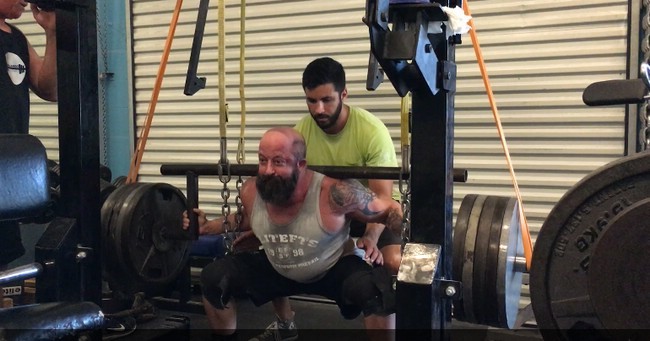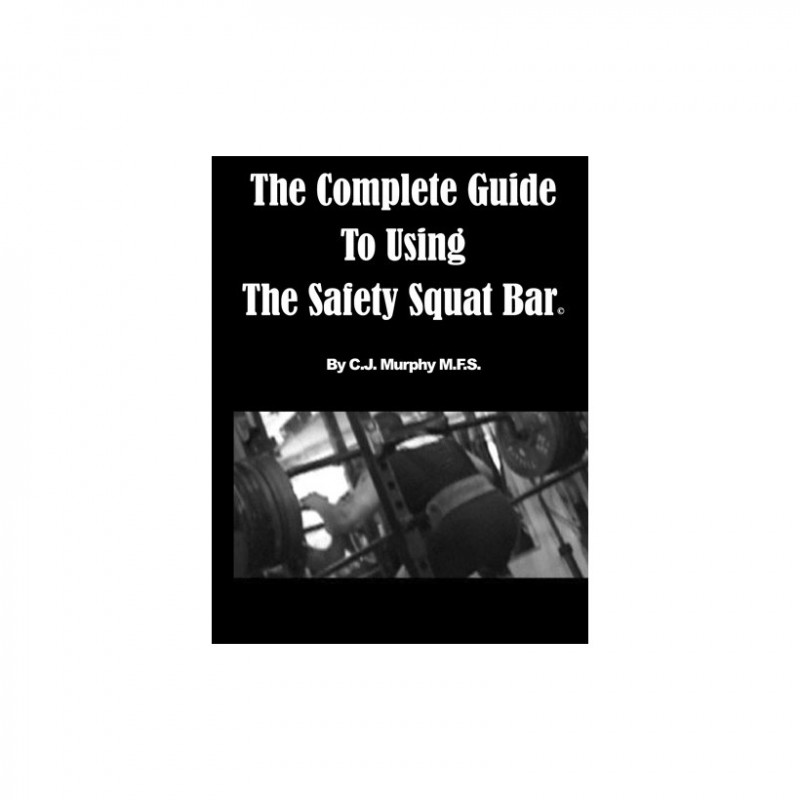
I get asked a lot of questions about the use of specialty bars almost daily.
Today, I’ll go over the three most popular (and effective) bars we have at our disposal:
- The Duffalo Bar
- The Safety Squat Bar
- The Cambered Bar
Before I review the specifics of each bar, let’s talk about why you would use a specialty bar.
I see a few reasons to use them and in no specific order, here they are:
- Work around injury
- Variety
- Build specific areas from weak to strong(er)
- Improve positions in specific lifts
Let’s address these one at a time.
Work around injury:
You want to train but sometimes you are banged up right?
Specialty bars can be just the ticket if you have an injury or a beat up area.
These bars are usually best for shoulder injuries as they allow you to take the pressure off the shoulder girdle through different positions of the bar or not using the shoulder at all.
Lower body injuries can be trained around sometimes too. The Safety Squat bar is good for knee rehab and sometimes hip problems.
Using the handles if you have them or holding a rack and doing Hatfield Squats with the Safety Bar takes most of the shear force off the knee and allows many to squat pain free.
Hatfield Squats also take a lot of stress off the hip flexors and are a good choice if yours are in rough shape.
Variety:
Variety is good. It prevents boredom although I’ve never understood how someone could get bored with the basic lifts. They are technically demanding and each session should force you to focus and try to improve. That keeps me from getting bored.
Anyway; variety is also good for challenging your body. Many times the slightest variation on an exercise provides a new stimulus, and therefore a new chance to adapt to it by getting stronger.
This could be as small as changing your stance on the squat by an inch or two, or bringing the bar up higher on your back. The new position requires your nervous system and muscles to adapt in a small way.
Adding a Specialty Bar increases this factor enormously.
Therefore, in theory, it helps makes you stronger at the basic lift when you go back to it due to the new movement pattern.
Build specific areas from weak to strong(er):
Specialty bars can be used to build strength in lagging areas such as the upper back, hips, triceps and more.
For example, the Safety Squat bar builds massive strength in the upper back when used for Squats and Good Mornings. It can be a huge tricep builder too. Add in some Safety Bar JM Presses. They are easy on the elbows and hard on the tricep muscles.
The Cambered Bar builds the ass and hips like a mo-fo. It can also take a good deal of stress off the shoulders for many.
These are just a few examples.
Improve positions in specific lifts:
I’m big on perfect technique with my athletes. I always tell them that form and technique are more important than the weight on the bar.
If you are using a weight that is too heavy and getting in shitty positions, all you are doing is reinforcing strength imbalances and creating a bigger weakness in the an already weak area.
Specialty bars can help improve positions, especially when using exercises to correct positions.
Let’s use a geared lifter as an example.
Box squats are used to build strength, but can also be used to improve position.
If we have a lifter that dumps out of the hole there are a many choices we can use to fix this, but using a Safety Bar and a box squat, we can duplicate the bottom position of the squat for them and use the bar to increase the forward dump. The weakness can be fixed by stressing a good position on the box and driving into the Safety Squat bar with the upper back as you descend and rise off the box.
Again, this is just one example of how a Specialty Bar can be used.
Now, let’s look at the bars themselves.
The Duffalo Bar

Chris Duffin is a fabrication wizard. He makes some of the highest quality products I have ever seen and this bar is one of them.
The Duffalo Bar is used primarily for Squats and Good Mornings, but can be used for Bench Presses and other exercises.
The bar is arched, meaning the sleeves where the weights go are lower than the center of the bar, placing the weight closer to your center of mass.
This, theoretically allows you to lift more as the weight is closer to your center giving you a greater mechanical advantage. Another benefit is that the lowered ends are easier on your shoulder joints.
By having a “drop” at the end, your shoulders are put in a position that makes it easier to hold the bar.
The bar is also longer than a regular bar which makes it easier for bigger lifters with tight shoulders to get under it and lift pain free. If you fall into this category, don’t just use the bar to train pain free.
Do something to correct your issues so that when you return to the straight bar, you can do that pain free too. It could be as simple as using a few Acumobility balls between sets on your pecs, upper back and the Eclipse Roller on your teres. A minute of work on your rest periods between sets with these tools will pay off quickly. Pairing this with a bar that allows you to lift without pain may get you back to lifting 100% fast.

This one is used less frequently, but I don’t know why.
The Cambered Bar has a large drop. I have an old EliteFTS Rackable one and the drop is 12”. There are many different types and the drop may be slightly different, but it is huge.
(Drop is the posts that extend downwards from the part of the bar that rests on your back to the sleeves where the weights go)
The large drop places the weight more on your hips and posterior chain (ass, hammies & lower back) and will exploit any weakness you have there when squatting or deadlifting.
The large drop also causes you to really tighten up your gut and brace the shit out of it because if you are loose in the belly, the weights will swing back and forth.
And another thing, the Cambered Bar allows multiple hand and grip positions making it extremely versatile.
Of all the three, this is my favorite.
The Safety Squat bar has a camber and a drop. It also has thick pad at the top where you place it on your back.
The combination of these three things makes this bar a real ass kicker.
The SSB does not require you to grab the bar per-se, it will just rest on your traps as long as there is at least one plate on it. However, it is best used by holding the end of the yoke.
Holding the end of the yoke makes this the easiest on the shoulders of all three bars allowing those with limited mobility or injuries to the shoulder to squat safely.
The SSB also sits high on your back making it a killer on the upper back, therefore it will build your squat and deadlift by strengthening this area. Fast.
It is also very easy on the knees, hips and lower back, while annihilating your quads when used to perform Hatfield squats.
The Hatfield squat minimizes damaging shear forces on these areas making it a perfect choice for working around injuries and for rehab.
For full details on the bar, get my book.
So, what’s that Specialty bar for?
Here is a quick list of the what’s and why’s. It is far from complete but hits the basics and will help you make a decision on when and why to use each one.
ALL BARS ARE PRIMARILY USED FOR SQUATS AND GOOD MORNINGS
Duffalo Bar:
- Easy on the shoulders
- Can be used for bench presses; the angle of the arch provides a new stimulus and can build your bench
- Great for all types of Squats and Good Mornings
- Perfect for Frankenstein Squats; this is a front squat variation where you hold your arms out like Frankenstein while he walks
- The lower center of gravity forces you to brace harder, thereby making your torso stronger
- The lower center of gravity can allow you to lift more too, good for overload
Cambered Bar:
- Multiple hand positions making it a good choice for some with shoulder problems
- Awesome for Zercher squats and deads which build your backside from the traps to the hamstrings
- The drop makes the weights swing if you are loose. Getting tight makes everything better.
- Squatting with the Cambered bar smashes your hips, glutes and hamstrings in a good way making them stronger
Safety Squat Bar

I love this bar so much I wrote a book on it with full explanations on its origins, and use. It is the most versatile bar around besides the straight bar.
- The SSB builds your upper back due to the slight camber and drop
- The SSB increases the dump effect in squats and forces you to drive into it to correct the movement
- The SSB puts the weight HIGHER on your body, further away for your center of gravity making you work harder
- Perfect for Hatfield squats which target the quads like nothing else and also take a large amount of shear force off your knees and lower back when done properly
- Outstanding for rehab: I used it exclusively to come back from three knee surgeries
- Easiest of all the bars listed on the shoulders
- Can be used for bench press variations too
There you have it, a basic list of what’s that bar for.
There are tons of specialty bars on the market and they all have some value in your training.
I feel that these are the three best.
The most important part of all?

Each of the ones listed is proudly MADE IN THE USA by hard working Americans.
If you have any questions about something I didn’t list, please leave a comment and I’ll get back to you as quick as I can.
AND:

Today is the one year anniversary of the passing of my dear friend Ed Kelley.
Please take a moment and read my tribute to him.
Thanks for reading.
Oh, and one more thing:
Go to the Contest page on my site and sign up for the Malden’s Strongest Strongman show July 29th with 100% of the profit going to charity. Full details are on the page.
Ask me a question-Be sure and Type to Murph in the header
Find me on Google-search for Total Performance Sports Malden, Mass. The Best Gym in Boston, Facebook too.
Oh, yeah, follow us on Instagram too. TPSMalden
SHARE THIS!
#bostonsstrongest
Vincere vel mori












Vinceri vel Mori